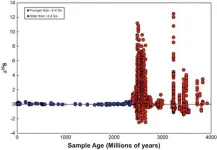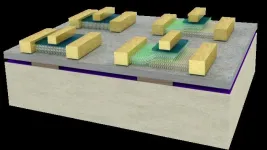(Press-News.org) An artificial intelligence with the ability to look inward and fine tune its own neural network performs better when it chooses diversity over lack of diversity, a new study finds. The resulting diverse neural networks were particularly effective at solving complex tasks.
“We created a test system with a non-human intelligence, an artificial intelligence (AI), to see if the AI would choose diversity over the lack of diversity and if its choice would improve the performance of the AI,” says William Ditto, professor of physics at North Carolina State University, director of NC State’s Nonlinear Artificial Intelligence Laboratory (NAIL) and co-corresponding author of the work. “The key was giving the AI the ability to look inward and learn how it learns.”
Neural networks are an advanced type of AI loosely based on the way that our brains work. Our natural neurons exchange electrical impulses according to the strengths of their connections. Artificial neural networks create similarly strong connections by adjusting numerical weights and biases during training sessions. For example, a neural network can be trained to identify photos of dogs by sifting through a large number of photos, making a guess about whether the photo is of a dog, seeing how far off it is and then adjusting its weights and biases until they are closer to reality.
Conventional AI uses neural networks to solve problems, but these networks are typically composed of large numbers of identical artificial neurons. The number and strength of connections between those identical neurons may change as it learns, but once the network is optimized, those static neurons are the network.
Ditto’s team, on the other hand, gave its AI the ability to choose the number, shape and connection strength between neurons in its neural network, creating sub-networks of different neuron types and connection strengths within the network as it learns.
“Our real brains have more than one type of neuron,” Ditto says. “So we gave our AI the ability to look inward and decide whether it needed to modify the composition of its neural network. Essentially, we gave it the control knob for its own brain. So it can solve the problem, look at the result, and change the type and mixture of artificial neurons until it finds the most advantageous one. It’s meta-learning for AI.
“Our AI could also decide between diverse or homogenous neurons,” Ditto says. “And we found that in every instance the AI chose diversity as a way to strengthen its performance.”
The team tested the AI’s accuracy by asking it to perform a standard numerical classifying exercise, and saw that its accuracy increased as the number of neurons and neuronal diversity increased. A standard, homogenous AI could identify the numbers with 57% accuracy, while the meta-learning, diverse AI was able to reach 70% accuracy.
According to Ditto, the diversity-based AI is up to 10 times more accurate than conventional AI in solving more complicated problems, such as predicting a pendulum’s swing or the motion of galaxies.
“We have shown that if you give an AI the ability to look inward and learn how it learns it will change its internal structure – the structure of its artificial neurons – to embrace diversity and improve its ability to learn and solve problems efficiently and more accurately,” Ditto says. “Indeed, we also observed that as the problems become more complex and chaotic the performance improves even more dramatically over an AI that does not embrace diversity.”
The research appears in Scientific Reports, and was supported by the Office of Naval Research (under grant N00014-16-1-3066) and by United Therapeutics. John Lindner, emeritus professor of physics at the College of Wooster and visiting professor at NAIL, is co-corresponding author. Former NC State graduate student Anshul Choudhary is first author. NC State graduate student Anil Radhakrishnan and Sudeshna Sinha, professor of physics at the Indian Institute of Science Education and Research Mohali, also contributed to the work.
-peake-
Note to editors: An abstract follows.
“Neuronal diversity can improve machine learning for physics and beyond”
DOI: 10.1038/s41598-023-40766-6
Authors: Anshul Choudhary, Anil Radhakrishnan, John F. Lindner, William L. Ditto, North Carolina State University Nonlinear Artificial Intelligence Laboratory; Sudeshna Sinha, Indian Institute of Science Education and Research Mohali
Published: Aug. 21, 2023 in Scientific Reports
Abstract:
Diversity conveys advantages in nature, yet homogeneous neurons typically comprise the layers of artificial neural networks. Here we construct neural networks from neurons that learn their own activation functions, quickly diversify, and subsequently outperform their homogeneous counterparts on image classification and nonlinear regression tasks. Sub-networks instantiate the neurons, which meta-learn especially efficient sets of nonlinear responses. Examples include conventional neural networks classifying digits and forecasting a van der Pol oscillator and physics-informed Hamiltonian neural networks learning Hénon–Heiles stellar orbits and the swing of a video recorded pendulum clock. Such learned diversity provides examples of dynamical systems selecting diversity over uniformity and elucidates the role of diversity in natural and artificial systems.
END
UNIVERSITY PARK, Pa. — Kenneth Davis, professor of atmospheric and climate science at Penn State, will lead a team of 23 investigators from 13 research institutions in a new field campaign supported by the U.S. Department of Energy (DOE) to study surface-atmosphere interactions around Baltimore, Maryland, to see how they influence the city’s climate. The new campaign, called the Coast-Urban-Rural Atmospheric Gradient Experiment (CoURAGE), is expected to start in October 2024 and run through September 2025.
CoURAGE will contribute to the Baltimore Social-Environmental ...
Infants who spent most of their first year in the pandemic have fewer types of bacteria in their gut than infants born earlier, according to a team of developmental psychology researchers.
The findings, published in Scientific Reports, showed that infants whose gut microbes were sampled during the pandemic had lower alpha diversity of the gut microbiome, meaning that there were fewer species of bacteria in the gut. The infants had a lower abundance of Pasteurellaceae and Haemophilus—bacteria that live within humans and can cause various infections—and significantly different beta diversity, which tells us how similar or dissimilar the gut microbiome for ...
A new blood test called p-tau217 shows promise as an Alzheimer's disease biomarker, and when used in a two-step workflow very high accuracy to either identify or exclude brain amyloidosis, the most important and earliest pathology. That is an innovation now presented by researchers at the University of Gothenburg, together with colleagues at University of Lund and in Montreal, Canada.
In recent years, a lot of effort has been put on developing biomarkers in blood that could potentially help to identify Alzheimer’s disease (AD). Tau protein, ...
Vitamin C and other antioxidants stimulate the formation of new blood vessels in lung cancer tumours, a new study from Karolinska Institutet published in The Journal of Clinical Investigation shows. The discovery corroborates the idea that dietary supplements containing antioxidants can accelerate tumour growth and metastasis.
“We’ve found that antioxidants activate a mechanism that causes cancer tumours to form new blood vessels, which is surprising, since it was previously thought that antioxidants have a protective effect,” says study leader Martin Bergö, professor at the ...
HAMILTON, ON (Aug. 31, 2023) – An innovative model of care that offers new mothers psychotherapy delivered by other mothers who have also experienced post-partum depression (PPD) should be implemented in clinical practice, according to researchers at McMaster University.
Researchers worked with nearly 200 mothers over a year and a half, during the height of the COVID-19 pandemic, and found those receiving treatment from their peers were 11 times more likely to experience remission of their major depressive disorder. The findings of the randomized control trial are published in Acta Psychiatrica Scandinavica.
PPD and its associated symptoms affect ...
About The Study: In a randomized clinical trial with 104 participants, psilocybin treatment was associated with a clinically significant sustained reduction in depressive symptoms and functional disability, without serious adverse events. These findings add to increasing evidence that psilocybin—when administered with psychological support—may hold promise as a novel intervention for major depressive disorder.
Authors: Charles L. Raison, M.D., of Usona Institute in Fitchburg, Wisconsin, is the corresponding author.
To access the embargoed study: Visit our For The Media website at ...
About The Study: The findings of this study suggest that patients with cancer had a disparate burden of COVID-19 mortality during the winter Omicron wave compared with the general U.S. population. With the emergence of new, immune-evasive SARS-CoV-2 variants, many of which are anticipated to be resistant to monoclonal antibody treatments, strategies to prevent COVID-19 transmission should remain a high priority.
Authors: Chi-Fu Jeffrey Yang, M.D., of Massachusetts General Hospital in Boston, is the corresponding ...
An international team of scientists have uncovered an important link between Earth’s early atmosphere and the chemistry of its deep mantle.
The study, which was led by researchers at the University of Portsmouth and University of Montpellier, sheds new light on the evolution of life on our planet and the rise of atmospheric oxygen.
The team investigated magmas formed in ancient subduction zones, where portions of Earth’s crust sink back into the mantle, from a pivotal moment in Earth's history – the Great Oxidation Event (GOE). This event, which is estimated to have happened between 2.1 ...
Ion channels are attractive drug targets due to their importance in health and disease, but finding ways to target a specific ion channel selectively is a major challenge. Now, researchers at Weill Cornell Medicine and RMIT University in Australia have discovered that ion channels called BK channels have unique openings in their sides, which drug molecules may be able to access. The finding, published Aug. 31 in Nature Chemical Biology, could lead to the development of selective drugs that target the BK channel to treat ...
We live in an analog world of continuous information flow that is both processed and stored by our brains at the same time, but our devices process information digitally in the form of discrete binary code, breaking the information into little bits (or bites). Researchers at EPFL have revealed a pioneering technology that combines the potential of continuous analog processing with the precision of digital devices. By seamlessly integratingultra-thin, two-dimensional semiconductors with ferroelectric materials, the research, published in Nature Electronics, unveils a novel way to improve energy efficiency and add new functionalities in computing. The ...



